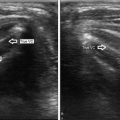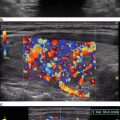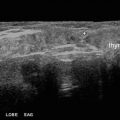Fig. 4.1
Layout for 15 × 12 ft left-handed ultrasound procedure suite including on-site cytologic adequacy assessment. Note that clean and dirty sinks are required for CLIA licensing along with microscope and digital photography recording on the second laptop to the right
Without on-site cytologic assessment, the second sink and countertop are not needed, thus eliminating 30–50 square feet of unnecessary countertop and bringing the total square footage down to 100–150 square feet (Fig. 4.2).


Fig. 4.2
Layout for 14 × 12 ft right-handed ultrasound procedure suite without on-site cytology assessment. Only a single sink is required and the wall flat panel is mounted at the head of the exam table rather than cross-table based on physician preference. The small flat panel with the ultrasound console is used for family display and education. The flat panel on the ceiling is for patient education
4.3 Ultrasound Equipment
Although sterilizable touchscreen, portable iPad-like US devices have gained some traction in the surgical community for intraoperative use, most endocrinologic ultrasonographers prefer traditional console devices for a single office or a portable laptop device with convenient plug and play platforms for multiple office use. Several issues must be considered prior to purchase:
- 1.
Does my allocated space accommodate the footprint of my ultrasound of choice?
- 2.
Are the ergonomics of my device and device location customizable for my specific needs (i.e., customizable for handedness, with multifunction foot pedals for taking biopsy images when my hands are otherwise occupied)?
- 3.
Do I have the correct transducers for thyroid, lymph node (LN), and parathyroid imaging and thyroid, parathyroid, and lymph node fine-needle aspiration (FNA)? For example, a flat 3–4 cm linear transducer packed with piano key-arrayed piezoelectric elements may suffice, but matrix array probes provide more piezoelectric elements per square millimeter of transducer face and often yield the sharpest central neck imaging. Lymph node (LN) imaging and biopsy may be best accomplished with more compact and maneuverable hockey stick transducers with fewer piezoelectric elements.
- 4.
Do I have the advanced technology that I need built into my device (e.g., color and/or power Doppler, video clip capture, virtual convex imaging) for structures that are larger than your transducer, strain vs. shear wave elastography for assessment of tissue stiffness, conventional linear array vs. matrix array transducer (discussed above), beam steering for difficult parallel technique FNAs, needle guidance software, crossbeam image enhancement, and easily controllable and customizable imaging protocols with on/off switches for different imaging needs.
- 5.
Will my ultrasound device power the wall-mounted flat panels I need for ergonomic cross-table viewing and the ceiling flat panel my patient needs for education? If not, can I purchase a compatible image splitter with a signal booster to power both flat panels?
- 6.
Can my ceiling monitor bracket be mounted into concrete or steel for maximum patient safety? Do ceiling lights or air-conditioning vents interfere with ceiling flat panel placement? Are there enough electrical outlets on the room walls and in the ceiling to minimize power cord length?
- 7.
Is there reporting software built into my machine that facilitates the incorporation of my measurements into detailed ultrasound reports along with automatically calculating nodule and LN volume for long-term follow-up?
- 8.
Does the US machine technology allow for simple, on screen, side-by-side comparison of old images and measurements with new ones?
Obviously, machine and room choice are the focal points for most entry-level ultrasonographers, but there is much more to an endocrine imaging practice than putting an ultrasound machine in an appropriate workspace. This theme in the literature does not receive enough attention; an editorial article published in 2011 by Nagarkatti et al. remains a relevant and practical resource to review for additional details (“Overcoming obstacles to setting up office-based ultrasound for evaluation of thyroid and parathyroid diseases”) [1].
4.4 Outfitting the Room
Room setup is essential to physician and patient satisfaction. The exam pedestal table and ultrasound device must be situated to accommodate the physician’s handedness and to allow the patient and physician to have ergonomic single visual field viewing of ultrasound images for teaching and needle guidance purposes. We have found that placement of a 36–42″ flat panel TV on a tilting ceiling mount affords the best image viewing for patients. Optimization of the physician viewing experience is accomplished by a second wall-mounted 36–42″ flat panel TV on a flexible metallic arm so that the patient’s neck, the biopsy needle, and the ultrasound image are all easily included in a single narrow visual field (see Fig. 4.3). Mounting of the flat panels should be handled by experienced video technicians, and the ceiling mount must be bolted into the concrete above any false ceiling materials and plugged into a ceiling outlet. For crisp video on two external monitors, many ultrasound devices require image splitters with signal amplification. Your video technician should be able to handle this installation and perform the necessary image optimization for your flat panel TVs.


Fig. 4.3




Proper flat panel placement. Note that the sidewall flat panel should be placed so as to allow the transducer, the patient, and the ultrasound image to all comfortably occupy the same visual field
Stay updated, free articles. Join our Telegram channel

Full access? Get Clinical Tree








